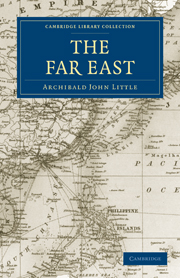Book contents
- Frontmatter
- PREFACE
- EDITORIAL NOTE
- Contents
- LIST OF MAPS AND ILLUSTRATIONS
- CHAPTER I DEFINITION
- CHAPTER II THE CENTRAL KINGDOM: CHINA
- CHAPTER III THE NORTHERN BASIN. THE YELLOW RIVER
- CHAPTER IV THE MIDDLE BASIN: PART I. THE YANGTSE RIVER
- CHAPTER V THE MIDDLE BASIN: PART II. THE PROVINCE OF SZECHUAN
- CHAPTER VI THE MIDDLE BASIN: PART III. THE CHENGTU PLATEAU
- CHAPTER VII THE MIDDLE BASIN: PART IV. THE LOWER YANGTSE PROVINCES
- CHAPTER VIII THE INTERMEDIATE PROVINCES
- CHAPTER IX THE SOUTHERN BASIN. YUNNAN TO CANTON
- CHAPTER X THE DEPENDENCIES: PART I. MANCHURIA
- CHAPTER XI THE DEPENDENCIES: PART II. MONGOLIA
- CHAPTER XII THE DEPENDENCIES: PART III. TURKESTAN
- CHAPTER XIII THE DEPENDENCIES: PART IV. TIBET
- CHAPTER XIV WHILOM DEPENDENCIES: PART I. INDO-CHINA
- CHAPTER XV WHILOM DEPENDENCIES: PART II. COREA
- CHAPTER XVI THE BUFFER KINGDOM: SIAM
- CHAPTER XVII THE ISLAND EMPIRE: JAPAN
- INDEX
- Plate section
CHAPTER VII - THE MIDDLE BASIN: PART IV. THE LOWER YANGTSE PROVINCES
Published online by Cambridge University Press: 05 October 2010
- Frontmatter
- PREFACE
- EDITORIAL NOTE
- Contents
- LIST OF MAPS AND ILLUSTRATIONS
- CHAPTER I DEFINITION
- CHAPTER II THE CENTRAL KINGDOM: CHINA
- CHAPTER III THE NORTHERN BASIN. THE YELLOW RIVER
- CHAPTER IV THE MIDDLE BASIN: PART I. THE YANGTSE RIVER
- CHAPTER V THE MIDDLE BASIN: PART II. THE PROVINCE OF SZECHUAN
- CHAPTER VI THE MIDDLE BASIN: PART III. THE CHENGTU PLATEAU
- CHAPTER VII THE MIDDLE BASIN: PART IV. THE LOWER YANGTSE PROVINCES
- CHAPTER VIII THE INTERMEDIATE PROVINCES
- CHAPTER IX THE SOUTHERN BASIN. YUNNAN TO CANTON
- CHAPTER X THE DEPENDENCIES: PART I. MANCHURIA
- CHAPTER XI THE DEPENDENCIES: PART II. MONGOLIA
- CHAPTER XII THE DEPENDENCIES: PART III. TURKESTAN
- CHAPTER XIII THE DEPENDENCIES: PART IV. TIBET
- CHAPTER XIV WHILOM DEPENDENCIES: PART I. INDO-CHINA
- CHAPTER XV WHILOM DEPENDENCIES: PART II. COREA
- CHAPTER XVI THE BUFFER KINGDOM: SIAM
- CHAPTER XVII THE ISLAND EMPIRE: JAPAN
- INDEX
- Plate section
Summary
The province of Hupeh, the second on our list, comprises in the main the lower Han valley in the north and the middle Yangtse valley in the south; the two valleys being divided by the range of the wild Tapa-shan, the same mountains that divide Szechuan from Shensi and which, in their prolongation eastwards, finally subside under the alluvial plain of the Hwai river. It lies between the thirtieth and thirty-second parallels of latitude and between seven meridians of longitude (109 to 116), the total area being 69,000 square miles, carrying a population generally estimated at 30,000,000 souls. Hupeh, literally translated, means ‘North of the Lake,’ the Tungting being the lake alluded to; the province by which Hupeh is bounded on the south being Hunan, meaning ‘South of the Lake,’ while the two provinces together are known as the Viceroyalty of Hu-kwang, meaning ‘Lake expanse,’—the ancient name of this region. The country here formed in prehistoric times a vast lake which the Yangtse had to fill up before it commenced to form its present delta. Hupeh may then have meant northern lake (expanse), and Hunan, southern lake (expanse). One half of the area of the province, the thickly populated central portion, an ellipse the two foci of which are the great marts of Shashih and Hankow, is an alluvial plain once a vast inland sea, to this day largely covered by lagoons and swamps, and in the frequently recurring years of flood reconverted into a lake of nearly the old surface dimensions.
- Type
- Chapter
- Information
- The Far East , pp. 91 - 109Publisher: Cambridge University PressPrint publication year: 2010First published in: 1905



